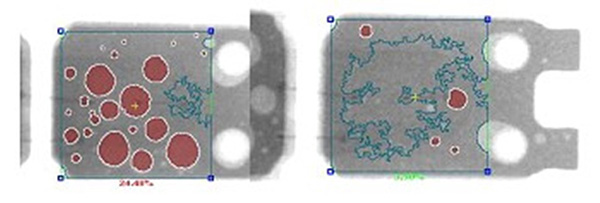Reflow Profiling in PCB Assembly
Optimizing temperatures will ensure the best possible conditions for soldering.
Verifying and optimizing the temperature profile of a reflow oven ensures an ideal thermal environment for solder paste to melt, flow and solidify, forming robust solder joints.
Calibrating the oven temperatures and ensuring they are set correctly involves sending a so-called “golden board” through the oven. Ideally, a “golden board” is supplied as part of the work kit by the customer or design team. This board (Figure 1) will be a sacrificial, fully populated assembly with (ideally five to seven) thermocouples attached via high-temperature solder in strategic locations across the assembly. It is processed through the reflow oven, collecting detailed information that technicians can use to make adjustments, ensuring the components and areas on the board stay within specified temperature constraints.

Figure 1. The golden board: expensive, but worth it?
Reality Check: Constraints in Reflow Profiling
The above describes an ideal scenario. The reality on the production floor is often much different. The engineer is often lucky if they can get one bare board to attempt a reflow profile. Frequently, profiles are an educated guess due to time and material constraints.
Also, many assume that because a modern reflow oven is very effective at introducing thermal energy into the assembly, the need for good profiling practice is less critical. In many cases, one can “set it and forget it” and still obtain acceptable results … until they are not. This is when good practice comes into play.
Problems with Improper Profiling Practices
Suppose an electronics manufacturing services (EMS) provider has a 1,000-piece build on a high-margin, high-visibility client. One of the QFN components has a void percentage specification of less than 30%. The acceptance run was performed on the NPI line; everything was within spec, and the customer was happy.
But the production run is performed on a production line with a smaller, older and less-capable oven. The voiding on the subject component exceeds 50% on the production run, and there is a scramble to pull together the information to understand and fix the issue (Figure 2).

Figure 2. Voids can be reduced with profiling techniques.
This scenario highlights several reasons why profiling is so important. The first reason is simple recordkeeping. In this case, a record of the profiles used on the NPI line could immediately be compared to the production line, making it easy to tell if the problem was in the settings or the oven’s calibration.
Reflow Profiling Best Practices
Proper reflow profiling can improve or eliminate defects. Void reduction (BTC and BGA) is one, as mentioned in the earlier anecdote, but also head-in-pillow (HiP) defects, wetting defects, residue characteristics and even flux cleaning, to name a few. Regular profiling also reveals how equipment interrelates to solder paste chemistry and other materials.
The following are some best practices to consider to avoid or mitigate potential problems.
Perform strategic profiling for every SKU/part number. The importance of meticulous record-keeping cannot be overstated. In a line-down scenario, every minute counts. Maintaining a comprehensive record of reflow profiles for every SKU/part number is not just about compliance, but about building a knowledge base that can significantly mitigate risks and improve the troubleshooting process.
Perform daily and production run profiles. Run a confirming profile at the beginning of each day and production run. This will identify any issues before the day’s production process has been compromised due to a failing fan motor or heating element.
Capture expertise and spread it around. Oven profilers are becoming more sophisticated, making profiling less arduous. Complex algorithms and software can make collecting and analyzing data more meaningful and faster.
But even with these advancements, profiling expertise is accumulated over time and experience. This expertise is often lost with personnel changes. Because of this, make reflow profiling part of the production environment’s culture; don’t rely on an individual expert.
Unlike other fixed variables in the PCB assembly process, such as solder paste formulation, PCB design and component placement, reflow profiling stands out as a dynamic element. It is the only place in a production line where the outcome can be impacted in real time. Assuming the print and placement processes are optimized, the oven profile is the only process that can be manipulated “on the fly” (Figure 3).

Figure 3. Understanding reflow profiling concepts can improve results in real time.
Have your paste or oven vendor spend a day on the floor for an oven audit and to educate your team on best practices. It’s painless and can pay big dividends.
is director of product management at AIM Solder (aimsolder.com); toneill@aimsolder.com.




